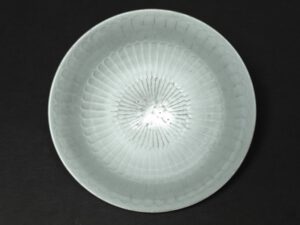
A Yuan Shufu Porcelain Chrysanthemum Bowl
A Yuan Dynasty Shufu Porcelain bowl, Hutian kilns Jingdezhen, Jiangxi province, c,1400-1450. This thickly potted bowl has a particularly thick base and square section foot, the body thins until it reaches the foliate rim at the top. Probably made using a hump-mould, the interior is moulded in light relief imitating an open chrysanthemum flower. The glaze has a typically greyish green tinge to it with some kiln grit in the well of the bowl and around the foot. During the Yuan period the Jingdezhen potters made some relatively minor adjustments to the highly successful qingbai glaze composition creating two new glazes, the shufu/luanbai glaze and as a further development the glaze was used with underglaze blue decoration. The basic difference between qingbai, shufu/luanbai and the glaze on the underglaze blue wares was the amount of calcium oxide they contained. Qingbai contains 12-13%, shufu/luanbai 5-6%, and the glaze used on Yuan blue and white wares was 8-10%.
SOLD
- Condition
- In good condition, three very minor shallow chips to the inside of the rim. Wear to the well of the bowl, this appears to be typical of Shufu ware.
- Size
- Diameter : 17.1 cm (6 3/4 inches) Height : 7.2 cm (2 3/4 inches)
- Provenance
- N/A
- Stock number
- 26113
- References
- For a similar Yuan Shufu Bowl, Presented by Sir Herbert Ingram, 1956 is in the Ashmolean Museum, Oxford see below for a photograph.
Information
Shufu / Luanbai
Shufu is a very specific type of Chinese white porcelain ware made during the Yuan dynasty (1279-1368) in Hutian village just outside the city of Jingdezhen, Jiangxi province. Thought to be the first known porcelain ordered by imperial officials. The body of the ware is covered with a soft, white, bluish opaque glaze similar to qingbai, but contained less calcium oxide resulting in slight translucency rather than transparency. The bases are unglazed and the paste is of the typical early natural porcelain clay of Jingdezhen. Many have moulded low-relief decoration. The ware takes its name from the Chinese characters shu and fu, which appear in low relief on the interior on some bowls and dishes (literally "central palace," or "privy council"). These are believed to have been made for the Shumiyuan, a government department. Other, auspicious, characters also appear on porcelains of this type, some of which were exported.
Luanbai (egg white glaze) and shufu are two different names for the same glaze. The term shufu became the accepted name (and more often used) as so many items with this glaze bore the characters of shu and fu in relief on their interiors. Their glaze was more opaque than that of qingbai and had a silky rather than a glossy texture, hence the ware's other name luanbai (egg white).
During the Yuan period the Jingdezhen potters made some relatively minor adjustments to the highly successful qingbai glaze's composition creating two new glazes, the shufu/luanbai glaze and as a further development the glaze used with underglaze blue decoration. The basic difference between qingbai, shufu/luanbai and the glaze on the underglaze blue wares was the amount of calcium oxide they contained. Qingbai contains 12-13%, shufu/luanbai 5-6%, and the glaze used on Yuan blue and white wares was 8-10%.
A Similar Yuan Shufu Chrysanthemum Bowl












